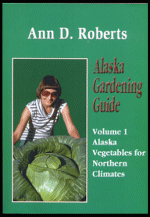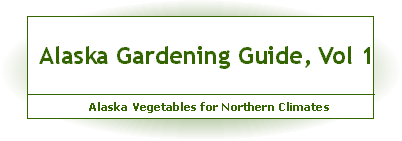 |
 |
Guide, Vol 1 ____________________ |
ISBN # 1-888125-54-3
- $29.95, second printing |
Sowing Success in Southcentral Alaska Part 1 of 3
This is part one of a three part series on gardening in Alaska, and more specifically, Southcentral Alaska. It covers cool weather, cold soil, and the top 10 soil warming tips. For a more comprehensive treatment of the subjects mentioned, please see Alaska Gardening Guide, Vol. 1.
©2005,Ann D. Roberts
Many gardeners, newly transplanted to Alaska, have despaired of ever growing more than greens that bolt to seed before they’re worth picking, seedlings that just sit (waiting for warmer weather), or plants killed by frost before they can produce. The lesson? Gardening in Alaska is different from the “lower 49” states. But by learning a few things about those differences, any Southcentral or Kenai Peninsula gardener can find gardening success. And many of the lessons learned here can help others who garden in far northern states, or even Canada.
A few challenges gardeners face in this area of Alaska are naturally cool weather, cold soil, and, paradoxically, too much daylight! Fortunately, solutions are close at hand—a combination of soil warming techniques and careful variety selection.
Cool Weather
Little can be done about weather, though soil warming techniques will help a little, and variety selection (covered later) is very important. The Matanuska Valley may have lush lawns because of more rain, but don’t think you can skip watering – Anchorage actually only averages a few inches more water per season than Fairbanks; it is cloud cover that makes the difference. Cloud cover ensures heat accumulation remains low in Southcentral and many plants will need greenhouse protection to mature here. The lower Kenai Peninsula stores up even fewer “heating degree days”.
Permafrost and Cold Soil
In Southcentral and Southeastern Alaska permafrost (ground that remains frozen all summer) occurs only sporadically, in isolated and often widely separated masses. A boggy or swampy surface may indicate the ground is too frozen to allow drainage. But if the surface insulation (often peat moss) is removed, the permafrost can then melt down to a level that permits good natural drainage. Unfortunately, soils in Alaska are cold even where there is no permafrost at all!
10 Soil-Warming Tips
The most frequent recommendations for soil warming are:
raised beds
clear plastic
lightening heavy soils
(The three items above are discussed more fully in part two of this series)
Other home gardening possibilities are planting in the sunniest spot, using greenhouses or hot frames, putting Styrofoam® insulating boards and/or heat tapes below the plants’ root zone, and utilizing solar collectors. If possible, water with tempered (warmed) water.
For vegetables not under plastic, sprinkler irrigation is most often recommended for Alaska, as warm air helps warm sprinkler water. Avoid sprinkling beans, which are particularly susceptible to soil-born disease organisms, spread by splattering water drops.
Ann D Roberts is the author of Alaska Gardening Guide Vol 1, covering cold weather gardening in Alaska, with specific growing tips for vegetables. The book, written and published in Alaska in 2000, is already the “definitive and indispensable reference guide to every Alaskan gardener.” Readers can check out its table of contents at http://AlaskaGardeningGuide.com. Ann is presently working on Vol 2, covering perennials and lawns. This article may be freely reprinted only if done so in its entirety, including this final paragraph.
Copyright 2002-2011, Aurora Webmasters Last updated January 24, 2012 Contact the Author, Ann D. Roberts. a member of the Garden Writers Association
by e-mailing: author*@*alaskagardeningguide.com (delete every *)